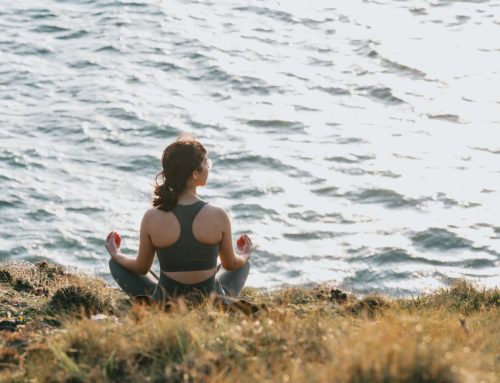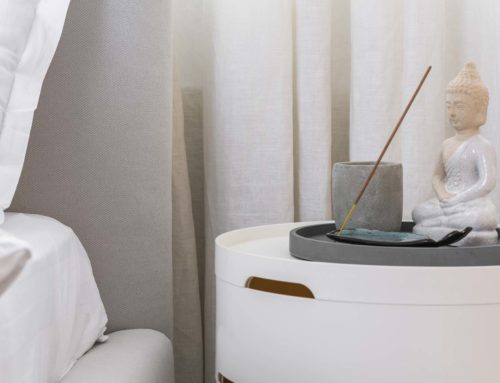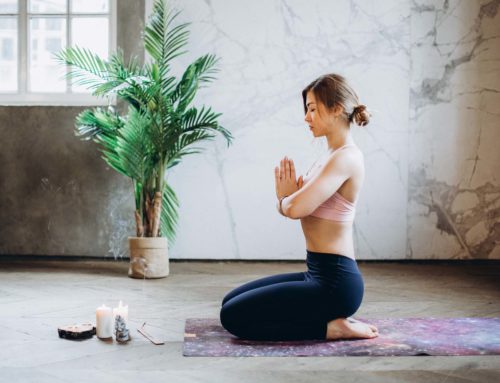In our modern world of technological distractions, world climate change, and constant fear-inducing rhetoric on the media, it’s not hard to believe that these days have the most stressed generations in history. But what can you do to alleviate this stress and transform yourself into a more positive, stress-free you? The energy received through Reiki healing is just one of the solutions and steps to a wholesome and stress-free life.
After identifying the need to decrease stress in your life, Mindbodygreen maintains that it is important you act upon it. Here are the key actions you can take to reduce stress and get your life closer to the one you imagine.
1: Healthy lunch by Tella Chen @ Flickr
Finding a wholesome, balanced, and feel-good diet.
Our bodies are our most precious possessions and treating them with respect and care are key to a healthy and balanced life. Not only is it important to think of how harmful food is to your physical body (weight, cholesterol, etc.), but you also need to think about how certain foods affect your mood and stress levels.
There are several foods that produce certain chemicals in our brains that can make us happier and calmer, such as dopamine, a pleasure-inducing chemical. Leafy greens are a prime example of such foods that according to Health.com has been proven in middle-aged and elderly who consume more greens to provide a “lower risk of depression symptoms than those who took the least”. Anyone whose had a big Thanksgiving dinner won’t be surprised either to hear that turkey breast is another food item that is great for relaxation and stress-relief. This is because turkey helps to produce the serotonin chemical, which promotes happy feeling and well-being. This is why after a big turkey dinner we can sometimes feel sleepy and content, because we are being flooded with calming chemicals. Other great foods for stress relief are oatmeal, salmon, blueberries, pistachios, dark chocolate, and milk.
The next key to a diet that won’t just make you feel good physically but also mentally is organic fresh produce. It’s commonly known that organic food generally contains higher levels of important nutrients that keep us feeling good and healthy. A lot of these nutrients are key to keeping our bodies feeling good and leaving us feeling good too. Organic food also contains a lot less artificial chemicals, like pesticides and preservatives that can strip produce of the nutrition and keep us from those good chemicals that keep us feeling good. Learning to check food labels will go a long way in helping you understand what you eat and what impact your food has on your health.
In all, finding the right diet for you is the key to success. Radical diets of any kind or changes in the way we go about our shopping and eating habits can be quite disorienting and might be hard to stick to after a while. WebMD stresses finding a diet that matches your lifestyle and focusing more on creating a healthy living plan around your current routine. Don’t think you can cut out half the calories you eat and completely change the kinds of foods you eat in one day. Find what you’re comfortable and work up to it by choosing healthier or organic options and include an exercise plan into your program.
2: Joyous running by Joshua Kehn @ Flickr
Establishing a routine of exercise and high intensity workouts.
Exercise is a commonly known solution to stress and many even credit the reason they became dependent on sports or athletics on their need to alleviate their stress levels. There’s been evidence for a long time that there’s a correlation between regular exercise and increase in self-esteem, improved sleep, and stabilized moods. But what exactly does exercise do for our brains? Which workouts play more to reduced levels of stress? And what else can you do beyond the average exercise routine?
It’s said that exercise in any form produces hormones in the brain that improve cognitive function, mood, and understanding. This is really important because stressful feelings affect things like memory and rational thinking in the brain, which you may have seen in action one jam packed day when everything seemed to go wrong, like forgetting your keys or accidentally running a red light. So when we’re running or doing aerobic exercises, our brain is reversing this affect by producing these hormones that can help us combat irrational or forgetful thought processes.
The most effective way of getting this feeling is through intense cardio, like running, bike riding, or dancing. These three in particular promote a feeling of happiness, and it’s been proven that people right after this kind of exercise feel lower rates of “depression, tension, and anxiety” according to Huffington Post.
There’s also been a lot of research into why people tend to feel less symptoms of anxiety and stress after boxing or other physically intensive sports. Although we all know that punching something feels good, what exactly is it doing to make us feel that way? The most common explanation for this is that the puncher is imagining the bag as the person or thing that’s producing stressful feelings in their life, and the act of physically beating that image is therapeutic. But just like any exercise, physically intensive sports are great producers of endorphins and adrenaline which leave you feeling good after your workout and energized to take on other things. The added benefit of punching, is that it requires a lot of focus and concentration, which can direct your attention towards something other than your stressor and calm your nerves in general.
In order to get the most out of your exercise plan, make sure to keep it diverse and include lots of high intensity cardio intervals throughout your routine. Try taking different classes at your local gym or community center, once a month maybe, to also see if there are certain sports that push you the most and make you feel the best after trying them. Whatever your plan, make sure that it not only makes you feel good after, but you also have fun doing it. Soon enough you’ll find not only that your body is healthy, but your mind is too.
3 Meditation by Moyan Brenn @ Flickr
Maintaining an arena for reflection and visualization.
Meditation, yoga, and Pilates are some of the biggest and most popular solutions to stress in all walks of life. The concept here is that giving people spaces to relax their bodies and free up their mental space will allow them to reach new heights of happiness and mental wellness. Beyond these strategies, however, exercising your mind in the right way can help you overcome some of the causes of stressful feelings.
In sports we use visualization to create muscle memory, a trick that tricks our minds and bodies to perform complicated actions and movements as a natural instinct. Major James Nesmeth is one of the world’s best stories of visualization and the power of the mind to control one’s body. Major Nesmeth was a prisoner of war in North Vietnam where he spent seven whole years of his life. He came into the prison as an average golf player by hobby, and with nothing else to do in solitary confinement, he made a commitment to use his time well.
Every day for seven years he played 18 holes of golf completely in his own imagination. He imagined his swing as he stood at the top of the pitch. He imagined the smell of nature around him as he walked the course. He even imagined the feel of the club in his hands as he hit that last put into the hole.
When he returned home after those seven years, he and his friends were astounded to find that he improved drastically in his game. No longer average, he could probably compete with some of the best amateur athletes out there. By simply visualizing his goal and imagining every step he had to do to get there, his body had trained itself to mimic what his mind was trying to do every day.
This concept doesn’t only have to apply to sports, however. When we have a goal in mind, whether it’s to improve one’s body, to succeed in your career, or simply to get through the monstrous to-do list we’ve accumulated, the secret to success is reflection and visualization. Giving ourselves the time and space – or arena as we call it – to explore one’s internal state and visualize where we want our physical selves to be at the end of our goals, we can achieve a state of wellness and happiness like never seen before.
Focusing on positive mindfulness and find environments that promote happiness.
Associate professor at the Harvard School of Public Health, Laura Kubzansky, says that positive thinking has mysterious powers when it comes to leading people to a healthier and happier life. She even noticed in her research that such positive thinking can even lead to a lower risk of heart disease in some cases.
As About Health states, positive thinking psychology is about taking on life with a consistent positive outlook, despite the situations that perhaps push one to negative thoughts, anger, or sadness. It goes much beyond just simply changing the way you think, but also pushing yourself to think about each perceived speed bump in life as an opportunity instead of your downfall.
There is even a strong link between where you live and your overall level of happiness. In countries with more socialized and individualized cultures, people tend to be happier as backed up by multiple studies. The study at the forefront is the World Happiness Report, which every year delivers a list of countries around the world ranked on a scale of happiest to least happy.
Countries over the years that have held positions at the top are Denmark, Switzerland, Iceland, Norway, and Canada. Again the obvious connection of these countries are their socialized politics. A huge indicator in this particular study, however, focuses on purchasing power of citizens, generosity according to charity participation, freedom of choice, life expectancy, and external social support. This is all then measured on positive affect dependent on laughter, happiness, and enjoyment compared to the day before (with a negative equivalent measurement).
All this research proves that the atmospheres that provide emotional support and encourage positive outlooks lead to not only less stressful thinking, but also general happiness. We can see then how environments that have less things to stress about – medical insurance, student loans, corruption, or military presence – can tend to have more room for a positive outlook on life. And although we know there are stressors no matter where you live, we can see through the research that having more control over what stressors interrupt your life can go a long way in making you feel happier and healthier.
As we like to say, by alleviating stressors and negativity in our lives we open ourselves up to things that we consider are aspects of a “whole” life. Rejecting these bad feelings through taking care of our bodies, pushing our bodies to be our best selves, giving ourselves time for reflection, and finding environments that promote positivity we begin on a path towards love, happiness, and wellness.
Leave us a comment letting us which one of these tips you have implemented into your life, and if you want to see how Reiki can help you simply contact us today!







